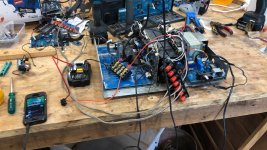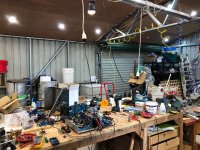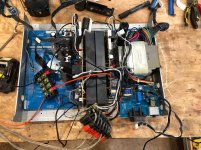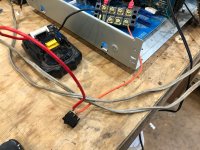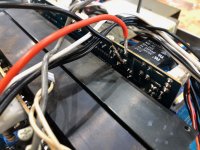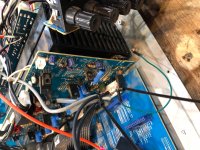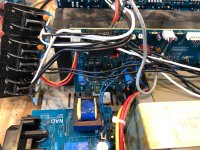So after posting this thread a while ago and losing interest in the project since then, COVID lockdowns and go-slows at work have given me the time and space to try and work this one out again.
I came across this video on youtube that was pretty close to what I needed, and provided some good inspo.
The main difference between his and mine is that I always suspected it was more the 'brains' rather than the actual hardware that was busted on my unit, so I was looking for a way to brute force it and inject a signal directly into the amp circuit.
First thing was to test the power supply. After jury rigging the standby switch to bypass the front panel, I found I was getting a reasonably consistent +- 50 volts on the primary, however all the secondary voltages appeared to be reading low. At this stage, I'd already comitted to bypassing the brains, but it could turn out that it was simply low voltages to that side of the unit that was causing me the issues. So Lesson Learned there. Mine isn't undoable, but for what I want I don't think I'll bother as I do have another NAD unit to work on (a T775) in the future.
After that, it was a matter of tricking the speaker relays to turn on. In testing these I may have fried the main front L/R relays by putting the reverse voltage on them (oops). I 'think' it's repairable, but I proceeded with the surround speakers anyway as each channel is basically the same circuit. My power source is a LiON battery, with some leads soldered onto where the relay connects to the board. I wired in a little rocker switch so I can turn this on/off as needed.
The grey lead coming from the pre-amp board is where the audio signal come in. To get me started, I just snipped this and spliced this onto a headphone to RCA lead that I also snipped, and just wired it in. Audio source is spotify on my phone, and volume is controlled there as well.
Et Voila, IT VERKS!!!!
Note these photos are dodgy as hell as this is just a bench test, but I'm ecstatic that the proof of concept is working. One cool thing I've noticed is how my current limiting lamp throbs in time to the music.
Next steps will be:
1. General housekeeping of wires for neatness and safety
2. Work out where I can obtain the required voltage from the unit itself to trigger the speaker relay, rather than relying on an external source.
3. Consider a volume control dial on the unit itself, rather than relying on the input (but this isn't a big deal for me).
4. Consider wiring the audio input to the factory front-input RCA plugs.
5. Gut the rest of the unit to remove superfluous bits and pieces, and mount everything neatly.
Happy for advice, comments, criticisms, etc. Go for it.
I came across this video on youtube that was pretty close to what I needed, and provided some good inspo.
The main difference between his and mine is that I always suspected it was more the 'brains' rather than the actual hardware that was busted on my unit, so I was looking for a way to brute force it and inject a signal directly into the amp circuit.
First thing was to test the power supply. After jury rigging the standby switch to bypass the front panel, I found I was getting a reasonably consistent +- 50 volts on the primary, however all the secondary voltages appeared to be reading low. At this stage, I'd already comitted to bypassing the brains, but it could turn out that it was simply low voltages to that side of the unit that was causing me the issues. So Lesson Learned there. Mine isn't undoable, but for what I want I don't think I'll bother as I do have another NAD unit to work on (a T775) in the future.
After that, it was a matter of tricking the speaker relays to turn on. In testing these I may have fried the main front L/R relays by putting the reverse voltage on them (oops). I 'think' it's repairable, but I proceeded with the surround speakers anyway as each channel is basically the same circuit. My power source is a LiON battery, with some leads soldered onto where the relay connects to the board. I wired in a little rocker switch so I can turn this on/off as needed.
The grey lead coming from the pre-amp board is where the audio signal come in. To get me started, I just snipped this and spliced this onto a headphone to RCA lead that I also snipped, and just wired it in. Audio source is spotify on my phone, and volume is controlled there as well.
Et Voila, IT VERKS!!!!
Note these photos are dodgy as hell as this is just a bench test, but I'm ecstatic that the proof of concept is working. One cool thing I've noticed is how my current limiting lamp throbs in time to the music.
Next steps will be:
1. General housekeeping of wires for neatness and safety
2. Work out where I can obtain the required voltage from the unit itself to trigger the speaker relay, rather than relying on an external source.
3. Consider a volume control dial on the unit itself, rather than relying on the input (but this isn't a big deal for me).
4. Consider wiring the audio input to the factory front-input RCA plugs.
5. Gut the rest of the unit to remove superfluous bits and pieces, and mount everything neatly.
Happy for advice, comments, criticisms, etc. Go for it.
Brilliant, I really like this kind of project...I have the amp section of a denon avr3300 running subs
